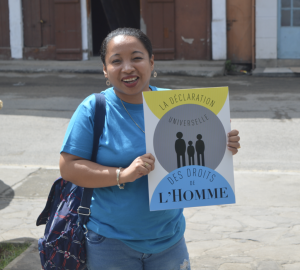Human Rights: What you need to know
Human rights are built around three main ideas: freedom, equality and the right to life. So it’s not just a vague idea.
Every day, newspapers, radio and television tell us about the world, so we can get an idea of whether human rights are being respected or flouted. In Syria, in 2012, faced with a violent civil war, thousands of citizens left their country, increasing the number of refugees in Turkey. In Bangladesh, seven-year-olds work as adults, while others on the African continent or in Madagascar live on the streets…
Human rights can be defined as those rights that every individual possesses simply by virtue of being a human being.The concept of human rights introduces the idea of justice and equality into the world.We enjoy our human rights when we go to school, when we are ill and see a doctor at the social centre or hospital, when we are ill and see a doctor at the social centre or hospital, when we are ill and see a doctor at the social centre or hospital,when we take part in activities organized by the Ministry of Youth, when we criticize government or opposition policy, take part in religious festivals or other cultural activities, when we listen to music or play soccer…
Human rights are violated when a man hits his wife or child, when a teacher humiliates his pupils, when pupils do not respect their teachers, when a family is homeless, when street children beg instead of going to school, when a person commits murder…In a state governed by the rule of law, anyone who flouts human rights must be punished by the law. The laws of a country must protect the weakest and must not accept the law of the strongest.
Human rights are universal, indivisible and inherent to Man. They cannot be taken away.
did you know?
- Human rights: Rights we have simply because we are human
- Civil rights: The right to have an identity, a birth certificate, an identity card.
- Political rights: The right to vote, to stand for election, to take part in a referendum.
- Economic rights: the right to work.
- Cultural rights: the right to have a religion, a culture, to dress as one wishes.
- The Universal Declaration of Human Rights proclaimed by the UN has been accepted by governments the world over.
- It was during the 20th century that human rights, through the UN and civil society, really took off.
- The concept of human rights is becoming increasingly accepted as human beings realize that its values are universal and transcend religion, culture and colour.transcend religion, culture and skin color.
- Whether we like it or not, human rights force human beings to improve…
Protecting Human Rights
The notion of justice and human rights has taken a long time to be accepted by the international community. UN member governments should protect vulnerable categories of the population and pass laws to this effect is now accepted as a matter of course.
Humanity has learned the lessons of history, and no longer treats women, prisoners, refugees, the disabled and homosexuals as it once did – at least in law. It recognizes that they are human beings in their own right (through UN Declarations, Conventions and other protocols) and as such cannot be discriminated against. The primary aim of these documents is to guarantee every human being the rights and freedoms necessary for survival, development and fulfillment, and to protect them against abuse.
It is therefore important for the citizens to know which instruments protect human rights, because it will be more difficult for a government to violate the rights of its people if those same people know their rights.

Etat de Droit
In everyday life, the law provides a framework for the lives of individuals. The highway code, for example, guarantees equal freedom to move about safely in the public space, by laying down traffic regulations. Committing a serious offence can result in imprisonment, which suspends our freedom of movement for a defined period of time.
The law applies to everyone without distinction. To live freely in society, people must behave responsibly. Common rules (written laws) are there to remind them: they form the law.
Law is therefore a social contract. It lays down the principles by which society is organized, and the rights and freedoms of its citizens. It also specifies the penalties for those who fail to respect them.
What is a Convention?
A convention is an international agreement on a specific theme: women, migrant workers, the disabled, etc. The convention forms part of international law and is binding. Any government ratifying a convention must ensure that its legislation is in line with it.
A UN convention is only applicable when more than a third of member states ratify it (sign it and accept its clauses).
What is a Declaration?
A declaration is an international document that announces to the world an important idea: that human beings are free and equal in rights (Universal Declaration of Human Rights, 1948), that children have rights (Declaration of the Rights of the Child, 1959).
A declaration, however, does not have the force of law, even if it carries moral weight. A Convention, on the other hand, is a binding instrument.
Read More on the Universal Declaration of Human Rights
did you know?
- We’re living longer and longer, and the percentage of elderly people is increasing in our societies. The UN and NGOs will be talking more and more about the rights of the elderly.
- Human rights instruments are important, but if laws prevent and punish, they can’t change age-old mentalities with a wave of a magic wand. Today, for example, one in four women in the world continues to be a victim of violence, despite the law.
- Human rights defenders are those who devote their lives to defending human rights. They work within associations and NGOs.
- The African Charter on Human and Peoples’ Rights is a very important tool for African states
- Ratify a convention: Sign and agree to abide by its terms.
- Non-governmental organizations (NGOs): Organizations created independently of government
UN & Human Rights
Humanity’s existence has always been punctuated by brutal conquests and merciless confrontations, among other bloody wars.
Since 1945, however, with the advent of the UN, we have begun to glimpse the hope of a better humanity. Indeed, the notion of a single human community learning to live together and develop with respect for human rights and peace is gaining ground. Even this idea will take time to develop in the midst of the planet’s contradictions…
The 20th century was a paradoxical century. Two world wars, real cataclysms, nearly 100 million dead. Unbridled economic development with no respect for planet Earth. But it was also a century of extraordinary progress in women’s rights, children’s rights, democracy and human solidarity.

With new ideas on human rights, the need for world government, and the importance of considering ourselves world citizens…Humanity has no choice. If we are to survive as a species, we are condemned to abandon the violent and unjust world of our ancestors and build a new one where human rights are firmly on the agenda, so that the 21st century is one of renewal.
What is United Nation?
The United Nations (U.N.) is an international organization that brings together almost every country in the world. It is responsible for enforcing world peace and managing conflicts and wars. The UN also helps bankrupt states or those hit by natural disasters (cyclones, earthquakes, tsunamis) or human catastrophes (wars). The UN works to defend human rights.
Intellectuals from different countries meet to draw up the Charter of this new organization, i.e. the rules, laws and obligations. The three main objectives of the UN are:
– To maintain world peace and save succeeding generations from the scourge of war.
– To reaffirm the international community’s belief in fundamental human rights.
– Promote social progress throughout the world through UN institutions (UNESCO, UNICEF, H.C.R., etc.).
How did UN emerge?
Between 1942 and 1945, while the Second World War was raging (more than 75 million people died in the period 1940-1945), the leaders of the great powers discussed the idea of a world organization to preserve peace.On October 24, 1945, after the war, 51 governments joined forces to create the UN.
did you know?
- Since 1945, the UN has grown from 51 to 194 member countries. A handful of states in the world are not members, and Switzerland has just joined. Although the UN flies a flag emblazoned with a globe, it is neither a superstate nor a world government, as member states retain their powers and sovereignty.
- The UN is more of a forum, a permanent place for discussion, negotiation and international decision-making. Above all, it is useful for promoting human rights worldwide through its specialized agencies. It is somewhat less effective when it comes to political decision-making, as its resources are limited by the sovereignty of individual states.
- A superpower can single-handedly defeat a UN resolution by using its veto power.
- To avoid conflict between the world’s five superpowers (the USA, France, China, Great Britain and Russia) and to ensure that the UN does not implode, the Organization has given them alone the right of veto, i.e. the right to say ‘no’, to oppose. This means that no important decision can be taken if one of the five superpowers opposes it.
- This right of veto may seem unfair, but it is the only way for the major powers to “agree to disagree” and remain within the organization. Without this agreement between the major powers, the UN would run the risk of being too fragile and therefore of breaking up.
